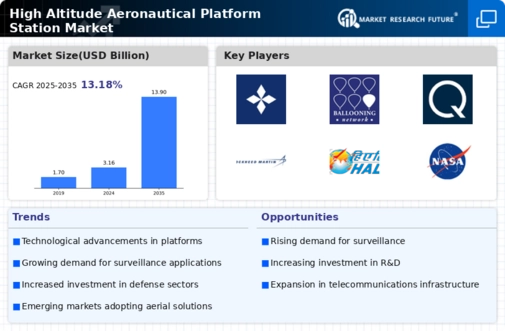Military Modernization Initiatives
The High Altitude Aeronautical Platform Station Market is significantly driven by military modernization initiatives across various nations. As defense budgets increase, countries are prioritizing the development and acquisition of advanced aerial platforms to enhance their military capabilities. This trend is particularly evident in regions experiencing geopolitical tensions, where nations seek to bolster their defense systems. The market is anticipated to grow at a rate of 12% annually, reflecting the urgency for modernized surveillance and reconnaissance systems. Consequently, the High Altitude Aeronautical Platform Station Market is poised for substantial growth as military forces adapt to evolving threats.
Growing Focus on Environmental Monitoring
The High Altitude Aeronautical Platform Station Market is increasingly recognized for its potential in environmental monitoring. With climate change and natural disasters becoming more prevalent, there is a pressing need for effective monitoring systems. High-altitude platforms can provide extensive coverage and real-time data on atmospheric conditions, pollution levels, and natural disasters. This capability is particularly valuable for governments and organizations aiming to implement effective environmental policies. The market is projected to expand as more stakeholders recognize the utility of these platforms in addressing environmental challenges, potentially reaching a valuation of USD 4 billion by 2027.
Advancements in Communication Technologies
The High Altitude Aeronautical Platform Station Market is significantly influenced by advancements in communication technologies. The integration of high-capacity data links and satellite communication systems enhances the operational efficiency of high-altitude platforms. These technological improvements enable seamless data transmission, which is crucial for military and civilian applications alike. As a result, the market is expected to see a growth trajectory, with estimates suggesting a market value increase to over USD 5 billion by 2028. Enhanced communication capabilities allow for better coordination in disaster management, environmental monitoring, and military operations, thereby driving the demand for high-altitude aeronautical platforms.
Emerging Applications in Telecommunications
The High Altitude Aeronautical Platform Station Market is witnessing emerging applications in telecommunications, which could reshape the landscape of connectivity. High-altitude platforms are being explored as potential solutions for providing internet access to remote and underserved areas. This capability aligns with The High Altitude Aeronautical Platform Station Market expansion valued at USD 3 billion by 2026. Telecommunications companies are increasingly interested in leveraging these platforms to enhance their service offerings, thereby driving innovation and investment in the High Altitude Aeronautical Platform Station Market.
Increased Demand for Surveillance and Reconnaissance
The High Altitude Aeronautical Platform Station Market experiences a notable surge in demand for surveillance and reconnaissance capabilities. Nations are increasingly investing in advanced aerial platforms to enhance their situational awareness and intelligence-gathering capabilities. The market is projected to grow at a compound annual growth rate of approximately 15% over the next five years, driven by the need for persistent monitoring of borders and critical infrastructure. This demand is further fueled by the rise in asymmetric warfare and the necessity for real-time data in military operations. Consequently, the High Altitude Aeronautical Platform Station Market is likely to witness a robust expansion as governments prioritize the acquisition of sophisticated aerial surveillance systems.


















Leave a Comment